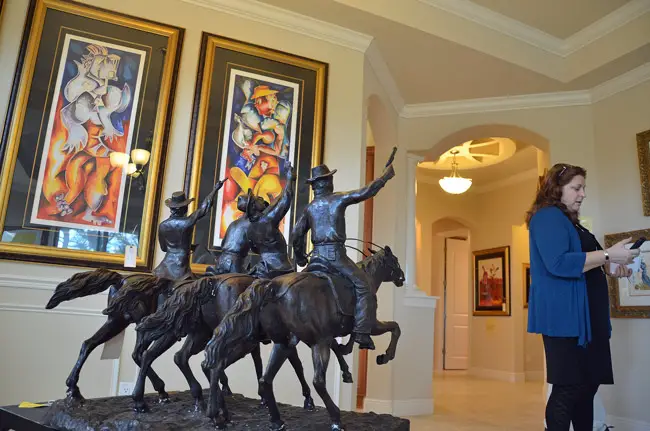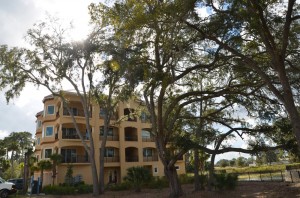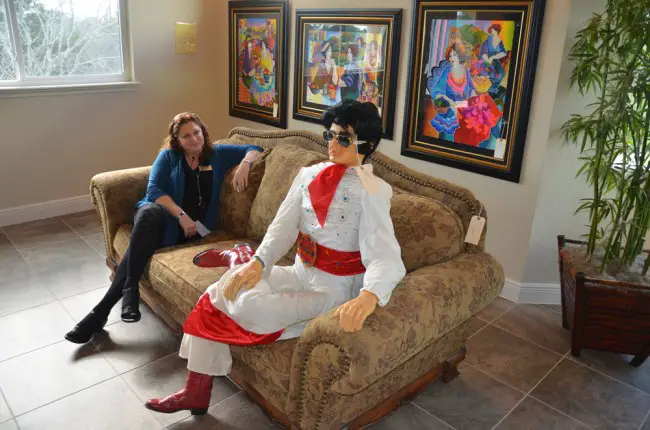
The bulky family bible, published by New York’s M.R, Gately & Co. in the late 19th century—with 2,000 “illustrative engravings in steel wood and in colors”—was “presented to my wife Minnie by her husband Dick” in 1882. It’s selling for a few hundred dollars. A hand-crafted Italian wedding chest large enough to be a Medieval coffin but likely a contemporary of that bible from across the ocean, got its mileage’s worth: it belonged to a woman with three marriages to her name. It’s selling for $6,000. An enormous Indonesian drum that sits on top of a cabinet, used for liquor by its last owner (the cabinet is, alas, empty), is selling for $2,000.
On the floor above, the walls and various surfaces of the 2,500 square feet condo are covered by some 100 pieces of fine art that belonged to a St. Augustine real estate professional who saw his business collapse and had to move out of his 8,500 square-foot home. The art he’s selling includes prints of Chagall, Dali, Picasso, a bronze replica of a sculpture by Frederic Remington (horsemen, of course, selling for $5,000), and a few pieces of not-so-fine art, including a life-size replica of James Dean ($995) and an equally life-size, but slightly inaccurate, replica of Elvis watching TV ($750). The inaccuracy: he’s not shooting the TV with a pistol, and there’s no hint of painkillers nearby.
You’re not always sure, walking through the rooms of the top two floors of the Hammock at Palm Harbor, whether you’re in a luxury condominium or a museum, though the price tags, elegant as they are, give it away. It’s essentially a garage sale within a garage sale (the condos are also on sale, at close to $400,000 a pop). But it’s for higher tax brackets where, in the more rarefied airs the language of the trade likes to put on, “garage sale” becomes “estate sale.”
And that business is booming, in Palm Coast as elsewhere.

To walk through the condo rooms with all their estate-sale furnishings and art pieces, and with Minotti, is to discover the intersection of several worlds most people glimpse on occasion here and there, but seldom in a single place. Minotti is mediator and translator between those worlds: she’s the one the elderly couple will call to liquidate their house when the couple needs to move to a smaller place, or to an assisted living facility. She’s the one the widow will call, despairing enough with the recent death of a spouse that the thought of liquidating whatever else remains in the house that must be sold is too much to deal with. In steps Minotti. She’s the one who’ll hear from the guy whose fortunes have turned drastically and who must get rid of everything as fast as possible, preferably for a few dollars more. She’s also the one the couple looking to furnish its bedroom with something of a colonial feel will call, to see what she’s come across lately. Collectors, “pickers” and re-sellers will call and drop in to see the latest she has to offer.
In “Pulp Fiction,” the 1994 Quentin Tarantino classic, Harvey Keitel is The Wolf who solves problems, usually involving cleaning the bloodied mess of murdered corpses. Minotti, 47, is kind of like that, though she bloodlessly tidies up the consequences of different unhappy ends, what she sums up as the four D’s of the estate industry business: debt, divorce, death and downsizing. Maybe it’s not a coincidence that Minotti, originally from New York, speaks with Keitel’s accent.
“I take on the position of guardianship of their cherished items,” Minotti says of the wares and furnishings and art she is charged with re-selling. “I don’t take it lightly.” And she has trouble saying no, even when the pay-off might not be as lucrative as estate sale managers can command. But the reality of the last several years is that it’s a great time to be in the business. “My business has avalanched,” Minotti says (she also donates a great deal of stuff, especially to hospice and to the local women’s crisis center.).
Estatesales.net, the web-based portal that helps people find estate sales in their zip codes, saw its listed sales double every year between 2005 and 2010, to more than 75,000 sales a week across the country. (There are two currently in Palm Coast.) It’s not just that the housing bubble burst and the economy tanked, triggering that tsunami of foreclosures. The crisis coincided with the start of what will be a long, and to estate sale organizers, profitable trend: the downsizing of baby boomers—“the baby boomers who overextended themselves,” Minotti says—or baby boomers’ own liquidation of their parents’ belongings. The estate sale season used to be spring and summer. No more. Death, debt and downsizing have made it a booming year-round business, and a handsomely rewarding one considering that the running commission for professional estate sale organizers is anywhere from 25 to 40 percent. And two things never stop: death and divorce.
In Palm Coast, there’s another factor that’s ticking up the number of estate sales: the so-called Palm Coast Pioneers, that generation of people who first moved into town in its first years in the 1970s, is dying off, leaving behind enough stuff for a whole new line of Tim LaHaye epics. But it’s not as if the younger generation is interested in it.
“You ask young couples today what China pattern they want, they look at you like you’re crazy. They’re registered at Target for an X-Box,” Minotti says, explaining how the generational divide keeps most children from wanting their parents’ things. More often, her clientele is the migrants from up north who thought they’d have to adopt a whole new Florida style down here, only to realize that they miss what they had back home, and want to reconstitute it here. So they go looking for the colonial furniture again, or what in the 1960s was considered contemporary décor. Either way, the impulse to own things that don’t look like what everybody else has keeps drawing those who can afford it to hand-crafted furniture, or old collectibles.
The prices are high end, but the buyers usually have the upper hand these days. “You have to be thick-skinned, because people are so, they know they can–,” Minotti looks for the right words. “They know how desperate people are.” There’s always bargaining going on at estate sales, which never stray entirely clear of the character of a Casablanca bazaar, but sometimes buyers will low-ball to the point of insult, knowing they have nothing to lose and, sometimes, plenty to gain.

Minotti has distaste for what she calls MDF furniture—medium density fiberboard, otherwise known as particle board, otherwise known as fake wood, otherwise known as the DNA of Ikea furniture. The Swedish home interior giant, so popular among the younger, poorer and hipper set, could not exist without particle board. Sure the alternative is more expensive. Sometimes a lot more expensive. But “if it’s lasted 100 years, it will last 100 years more,” she says, words she could never apply to particle board, whose lifespan is usually measured in the average length of a marriage.
Speaking of century-old work: as the walk through the condominium continues, there, springing up against the large bay windows, is the unusual sight of a series of Toulouse-Lautrec works, their so-Parisian misty luxury of grays and greens set against large windows giving onto Palm Coast’s brash green palms and cotton-clouded sky, a contrast any artist would appreciate for its ironies. Or a black-and-white Chagall print of his Jews in Egypt leaning against the same backdrop of red-tiled roofs and that other Florida specialty, asphalt, concrete and walls. Or all those oversize posters from turn-of-the-century France. You get the idea.
If nothing else, in a town that has yet to open its first museum, an estate sale—at least one organized as Minotti organizes it—is nothing short of a brief window into luxurious tastes and legacies dealt life’s inevitable blows. If you get lucky, you might even get to hear pianist Daniel Hardison play the Everett Parlor Grand this weekend. (The piano is selling for $7,200.) Those estate sales are ephemeral museums, with the added advantage that those who can afford it can always take a piece of them home with them. It doesn’t always have to be an expensive piece. Earlier today at the Hammock condos a woman was asking for a TV stand. There was none. But you never know what you’ll find. Including, in one closet, a series of Mickey Mouse art.





























Heather Beaven says
I have bought several items from Diana and every once in while I get a call to say “you have to see this.” She really gets to know her clients, their style and price range. I also know first hand how much she cares for other people’s treasures. I bought dining room chairs from her and she lovingly told me of the Marine Corps family who found them while stationed overseas thirty years ago. I feel in love and think of their heritage every time I look at them.
Pierre, you touched on her generousity to charities and people in need. You have no idea! I frequently find bags of stuff on my front porch with marching orders of who to deliver them too.
Diana is a treasure to Flagler County!!!
Rick R. Pinson via Facebook says
The Hammock at Palm Harbor Condos are really upscale residential style condos built by Eric Olsen of Olsen Custom Homes at the corner of Clubhouse Dr. & Palm Harbor Parkway, a really nice venue for the Art & Estate Sale hosted by Diana Minotti.
Perry Mitrano says
I could not be more proud and excitedfor my wife and to see this fine art collection.
Nice article Diana and just heard from my friends from all over the county and one in europe. You and Flagler Live are now world wide again!
Janice and Steve Scifo says
Personally and professionally, Diana Minotti is amazing. She is as sweet and wonderful as she is knowledgeable. In our estate planning practice we often come into contact with families of seniors who have passed away or moved to another state to be closer to family. I always call Diana to help in liquidated the home. I have given her some challenging jobs but she always shines.
Her estate sales are extraordinary! Her staging experience shows through.She is a joy to know and a pleasure to work with.